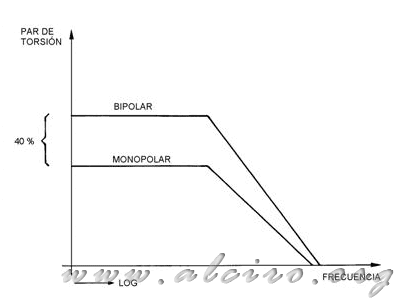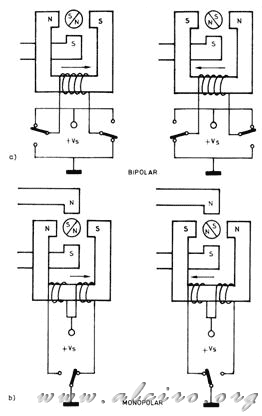4.2. Stepper motor bipolar and unipolar
The single most widespread and most used applications is the two-phase hybrid motor. This can be found with different combinations of excitation windings for different types of food.
Motor-bipolar: it has two windings, each corresponding to a phase. There are four wires, two for each winding. The control is performed is necessarily bipolar, usually with a jumper.
-Motor unipolar: the coil for each phase is twofold, together inside and placed in series gives us 6 wires, grouped in threes for each phase (one of which is common). The control is unipolar, but you can make a bipolar control number leaving the central thread in the air, not designed for this purpose.
Engine-8 strings: this is a double-winding motor as a unipolar motor, but with all terminals accessible from the outside. This allows multiple combinations of excitation, such as unipolar motor in threes uniting in opposition to the field and as bipolar motor with the windings in series or in parallel.
4.2.1. Relationship between torque and bipolar and unipolar excitation
The torque of a stepper motor is proportional to the intensity of the magnetic field generated by the stator windings. Can only be increased by adding more turns in the coil or increasing the current in each phase. The limit on the increased flow is the danger of the core reach saturation, although this is of minimal importance. What is more serious is the increase in engine temperature due to losses in the windings. This puts the unipolar motor at a distinct disadvantage on the pole, because this is a double resistance than the other, because the section of the wire is about half of the physical limitations of the cavity housing the stator windings.

Figure 4.16. Difference in the torque curve of an engine with bipolar and unipolar power.
In the bipolar motor winding current can be increased by a factor (√ 2), which has a direct effect on the pair. Thanks to its lower power loss, bipolar motors provide approximately 40% more torque than unipolar motors (Fig. 4.16.), Built in a housing the same size. On an equal par un motor bipolar I reduced in size.
Figure 4.17. shows the connection type and food for unipolar and bipolar motors.

Figure 4.17. Food and tip control for a motor with bipolar and unipolar power.







